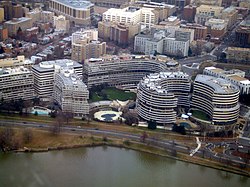
Back انتخابات الرئاسة الأمريكية 1972 Arabic ھەڵبژاردنی سەرۆکایەتیی ویلایەتە یەکگرتووەکانی ئەمریکا (١٩٧٢) CKB Præsidentvalget i USA 1972 Danish Präsidentschaftswahl in den Vereinigten Staaten 1972 German Προεδρική εκλογή των Ηνωμένων Πολιτειών 1972 Greek Elecciones presidenciales de Estados Unidos de 1972 Spanish انتخابات ریاستجمهوری ایالات متحده آمریکا (۱۹۷۲) Persian Yhdysvaltain presidentinvaalit 1972 Finnish Élection présidentielle américaine de 1972 French הבחירות לנשיאות ארצות הברית 1972 HE
This article needs additional citations for verification. (January 2025) |
| |||||||||||||||||||||||||||||
538 members of the Electoral College 270 electoral votes needed to win | |||||||||||||||||||||||||||||
|---|---|---|---|---|---|---|---|---|---|---|---|---|---|---|---|---|---|---|---|---|---|---|---|---|---|---|---|---|---|
| Opinion polls | |||||||||||||||||||||||||||||
| Turnout | 56.2%[1] | ||||||||||||||||||||||||||||
| |||||||||||||||||||||||||||||
 Presidential election results map. Red denotes states won by Nixon/Agnew and blue denotes those won by McGovern/Shriver. Gold is the electoral vote for Hospers/Nathan by a Virginia faithless elector. Numbers indicate electoral votes cast by each state and the District of Columbia. | |||||||||||||||||||||||||||||
| |||||||||||||||||||||||||||||
| Watergate scandal |
|---|
 |
| Events |
| People |
Presidential elections were held in the United States on November 7, 1972. Incumbent Republican President Richard Nixon defeated Democratic Senator George McGovern in a landslide victory. With 60.7% of the popular vote, Richard Nixon won the largest share of the popular vote for the Republican Party in any presidential election.
Nixon swept aside challenges from two Republican representatives in the Republican primaries to win renomination. McGovern, who had played a significant role in changing the Democratic nomination system after the 1968 U.S. presidential election, mobilized the anti-Vietnam War movement and other liberal supporters to win the Democratic nomination. Among the candidates he defeated were early front-runner Edmund Muskie, 1968 nominee Hubert Humphrey, governor George Wallace, and representative Shirley Chisholm.
Nixon emphasized the strong economy and his success in foreign affairs, while McGovern ran on a platform calling for an immediate end to the Vietnam War and the institution of a guaranteed minimum income. Nixon maintained a large lead in polling. McGovern's general election campaign was damaged by the perception that his platform was radical, and by revelations that his initial running mate, Thomas Eagleton, had undergone electroconvulsive therapy as a treatment for depression; Eagleton was replaced by Sargent Shriver after only nineteen days on the ticket. In June, Nixon's reelection committee broke into the Watergate complex to wiretap the Democratic National Committee's headquarters; early news of the incident had little impact on the success of Nixon's campaign, but further damaging revelations in the ensuing Watergate scandal soon engulfed his second term.
Nixon won the election in a landslide victory, taking 60.7% of the popular vote, carrying 49 states and becoming the first Republican to sweep the South, whereas McGovern took just 37.5% of the popular vote. This marked the most recent time that the Republican nominee carried Minnesota in a presidential election; it also made Nixon the only two-term vice president to be elected president twice. The 1972 election was the first since the ratification of the 26th Amendment, which lowered the voting age from 21 to 18, further expanding the electorate.
Nixon and his vice president Spiro Agnew both resigned from office within two years of the election: Agnew in October 1973 due to a bribery scandal, and Nixon in August 1974 in the face of likely impeachment and conviction as a result of the Watergate scandal. Republican House Minority Leader Gerald Ford, who replaced Agnew as vice president in December 1973 and Nixon as president in August 1974, thus became the only person in American history to attain the presidency without winning an election for president or vice president.
- ^ "National General Election VEP Turnout Rates, 1789-Present". United States Election Project. CQ Press. Archived from the original on July 25, 2014. Retrieved February 21, 2023.
Cite error: There are <ref group=lower-alpha> tags or {{efn}} templates on this page, but the references will not show without a {{reflist|group=lower-alpha}} template or {{notelist}} template (see the help page).
© MMXXIII Rich X Search. We shall prevail. All rights reserved. Rich X Search

